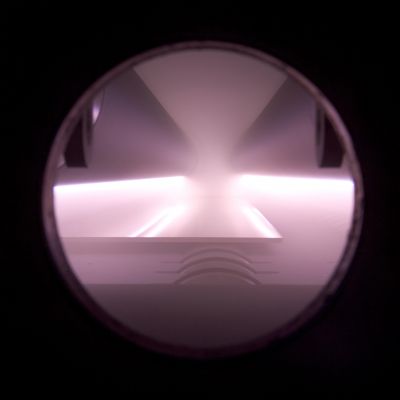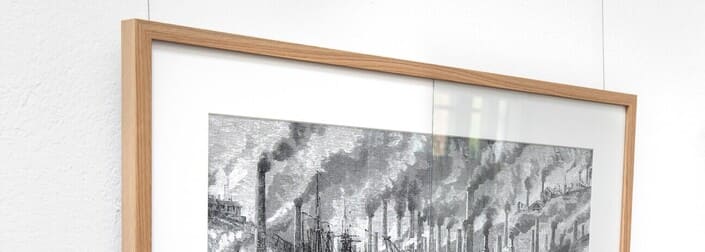Anti-reflective glass - the real view of the picture
When you look at a picture, you want to look at it undisturbed. Because hardly anything can be as disturbing as reflections in the glass surface. Therefore, glass is of enormous importance in framing. It stands between the picture and its viewer. Its tasks are manifold, ranging from protection against dust and contact to UV protection for the picture.
Glass manufacturing techniques are very old and date back to antiquity. As early as 1450 BC, glass was melted from quartz rock and plant ash. Nowadays, glasses together with their finishing are real high-tech products. High-quality anti-reflective glass with interference optics - also known as museum glass - is also becoming increasingly important in the glazing of paintings. We have Groglass and Tru Vue.
Anti-reflective glass FAQ
Glass for museums is picture frame glass that is specially adapted to the needs of museums or galleries. It can be made of real or acrylic glass and meets higher requirements for the reproduction and protection of the picture. By default, glass for museums is non-reflective, offers high colour rendering and usually protects the image from UV radiation.
In our knowledge section, you will find extensive information on the properties and manufacture of various types of glass for museums.
In contrast to frosted glass, glass for museums has an anti-reflective coating. The best way to recognise it is that it almost completely prevents light reflections. It appears almost "invisible" to the human eye. It also reproduces colours particularly brilliantly. This guarantees a true-to-the-original image presentation without disturbing reflections.
The surface of this glass is coated. Therefore, one has to be a little more careful when cleaning it, preferably wearing thin cotton gloves and using soft, lint-free cloths. Fingerprints can often be removed with a dry cloth.
Mild glass cleaners or a mixture of spirit and water can be used for heavier soiling. However, you should not spray the cleaners directly onto the pane, but onto a lint-free microfibre cloth.
Yes, it is possible to replace your existing glass with museum glass.
Which glass you need depends on the requirements for color reproduction, break resistance and anti-reflective coating. In general, normal glass, safety glass, acrylic glass and museum glass are all possible options.
Types of glass
Not all glass is the same. The market offers a large number of different types of glass with a wide variety of properties and prices. Basically there are mineral glasses or glasses made of plastic such as acrylic glass.
Anti-reflective glass
- Very high quality and anti-reflective white or acrylic glass
- Very high color rendering due to low reflections
- Very high UV protection
White glass
- Higher quality than normal glass
- Due to a lower proportion of iron oxide in the glass, the glass is much more color-neutral and is therefore better suited for the true-color presentation of images
Normal glass
- Also called "float glass," "mirror glass" or "window glass
- Flat glass produced in the float process
- Inexpensive glass, has a slight green tint due to its iron content, which leads to slight color distortion of the framed work
Acrylic glass
In addition to real glass, "acrylic glass" (or technically: polymethyl methacrylate) is often used in framing. The best-known brand is PLEXIGLAS®, which is often used as a synonym for acrylic glass in general. Even though acrylic glass is a plastic, the colloquial "plastic glasses" are often made of thinner low-grade materials. We offer only high quality acrylic glass.
In addition to the material, the surface has a major impact on the properties. Cheap glossy glasses often reflect strongly, and frosted glasses make colors look duller. Only high-quality interference-optically anti-reflective glass - also known as museum glass - offers an almost reflection-free view with the best color rendition. But these glasses are also very popular in private homes. We explain what's behind them.
Our anti-reflectiv glass
Artglass by Groglass
High quality interference optical anti-reflective glasses from the leading manufacturer in Latvia.
AR 70
The 3 millimeter thick glass offers excellent antireflection, unaltered colour rendition as well as very good contour sharpness and contrasts. The residual reflection colour corresponds to that of Mirogard. It offers 70% UV protection.
AR 92
With a thickness of only 3 millimeters, this museum glass combines excellent anti-reflective properties, undistorted colour rendition and 92% UV protection. It is ideal for conservation framing. The residual reflection colour corresponds to that of Mirogard Plus.
AR 99 Protect
TThis shatterproof laminated safety glass with a thickness of only 4.4 millimeters consists of two sheets with an elastic and tear-resistant synthetic film on the inside. In the event of glass breakage, this prevents the glass from shattering into small fragments. This is because large fragments adhere to it and thus remain in the frame. Thus, the work is protected. Long-lasting colour fidelity of artwork is ensured by the high UV protection of approx. 99 percent. The residual reflection colour corresponds to that of Mirogard and Mirogard Protect.
Tru Vue
High-quality interference-optical anti-reflective acrylic lenses from the well-known American manufacturer Tru Vue. Optium Museum Acrylic® combines many positive properties. It is anti-reflective, anti-static, shatterproof, scratch-resistant and protects against UV light. Therefore, it is the ideal solution for aesthetically demanding, very light and conservation framing. We carry 3mm, 4.5mm and 6mm thicknesses each as cut to size and sheet.
SCHOTT - no longer available
The German manufacturer SCHOTT has stopped the production of the high quality interference optical anti-reflective glasses. We offer as an alternative Artglass by the company Groglass.
Schott Mirogard®
The 3 millimeter thick glass offers excellent anti-reflective properties, unadulterated colour rendition as well as very good contour sharpness and contrasts. (no longer available)
Schott Mirogard® Plus
With a thickness of only 3 millimeters, this museum glass combines excellent anti-reflective properties, undistorted color rendition and UV protection of 82 percent. It is ideal for conservation framing. (no longer available)
Schott Mirogard® Protect
This shatterproof laminated safety glass is only 4.4 millimeters thick and consists of two panes with an elastic and tear-resistant film on the inside. This prevents the glass from shattering into small pieces in the event of breakage. This is because large fragments adhere almost flat to it and thus remain in the frame. Thus, the protection of the work can be guaranteed. Long-lasting colour fidelity of artworks is ensured by the high UV protection of approx. 99 percent. (no longer available)
Museum glass is synonymous in German-speaking countries with interference-optical anti-reflective glass. The glass is completely transparent and the image can be viewed true to the original. "Anti-reflective" glass is thus the optimal solution for unclouded enjoyment of art and meets the highest demands. We have been observing a steady trend towards anti-reflective glasses for years. The best-known manufacturers are Groglass with its Artglass series of mineral glasses, and Tru Vue, among others, with its Optium Museum Acrylic®. But what is behind the term interference optical?
Reflection-free through light waves traveling in opposite directions
In interference optical antireflection coating, the base material (usually real or acrylic glass) is coated with a large number of invisible layers of metal oxide only a few μm thick, each of which reflects a different waveband of light. They prevent reflections by the physical effect of destructive interference of light waves. In this process, depending on the length and energy of the reflected waves, the light waves traveling in opposite directions cancel each other out.

Layer structure of an interference-optical anti-reflective glass. Source: Tru Vue Inc.
But how does this work exactly? When light falls on the first coating layer, some is absorbed, some is reflected, and some passes through. When the light passing through reaches the next layer, the same process happens again. The light waves reflected from each material layer, interact with each other. Depending on the length and energy of the reflected waves, this interaction causes the opposing light waves to cancel each other out. This ensures colour-neutral light transmission. The prerequisite for freedom from reflection is a viewing angle of 90° to the glass surface, which is particularly the case when frames are hung in museums.

Layer structure of an interference-optical anti-reflective glass
To achieve this, 4-7 layers of different metal oxides are applied, depending on the product. The exact composition, layer thickness and exact number are factory secrets of the respective manufacturers. Typically, titanium dioxide and silicon dioxide (more precisely: TiOx, SiO2, Sn-ArH2, SnO2 or NbOx) are used.
Groglass and Tru Vue apply the coatings by magnetron sputtering. In this process, the metal atoms are evaporated in a vacuum chamber by cathode sputtering, then are deposited on the surface of the disk and bond insolubly. In total, the coating is only 0.2 micrometers thick per side. A human hair, on the other hand, is about 500 micrometers thick. To apply the various layers, each Optium Museum Acrylic® sheet at Tru Vue passes through a coating line more than 100m long - roughly the length of a soccer field. In total, the coating process takes several hours. The technical challenge is not to damage the heat-sensitive acrylic panes in the process.

View inside the magnetron sputter. Source: Tru Vue Inc.
The main difference between SCHOTT Mirogard, which is no longer available, and Artglass by Groglass is the coating process. While SCHOTT coated its glass in a dipping process and then baked it in the oven, Groglass, like Tru Vue, vaporizes its panes in a so-called sputtering process. Here, the metals are vaporized by plasma in a vacuum chamber and then deposit as an extremely thin layer on the glass and bond indissolubly with the surface. According to the company, the advantages of Groglass are lower energy consumption and more stable quality due to fewer coating defects. The surfaces are mechanically and chemically tested for durability.
Similar to an eyeglass lens, the glass surface remains smooth and reflections are reduced to less than 1% by the coating. The glass is completely transparent and the image can be viewed faithfully. "Anti-reflective" glasses are the optimal solution for unclouded enjoyment of art and meet the highest demands. The prerequisite is lighting at an acute angle. Windows facing the picture are not ideal.
Another advantage - high UV protection
Papers are particularly sensitive to light, especially UV light, which can cause severe damage in the long term. Even despite LED lighting, which is free of UV radiation, high UV protection of the glass is still very important. Our museum glass used has such protection. While normal glass blocks only about 45% of UV light, Artglass AR 92 protects 92% and Optium Museum Acrylic and Artglass AR 99 Protect protect over 99%.
One final note
Note, however, that before using Optium Museum Acrylic, you need to peel off the films attached to both sides. Also, be sure to clean the glass carefully, as residue is more noticeable with this glass than with conventional glass. However, if a glass pane breaks, you can easily replace it with a suitable replacement glass. Tru Vue and Groglass museum glass is ideal for exhibitions and for objects that have conservation requirements. No matter which glass you finally decide on, you are guaranteed to find it at HALBE!




